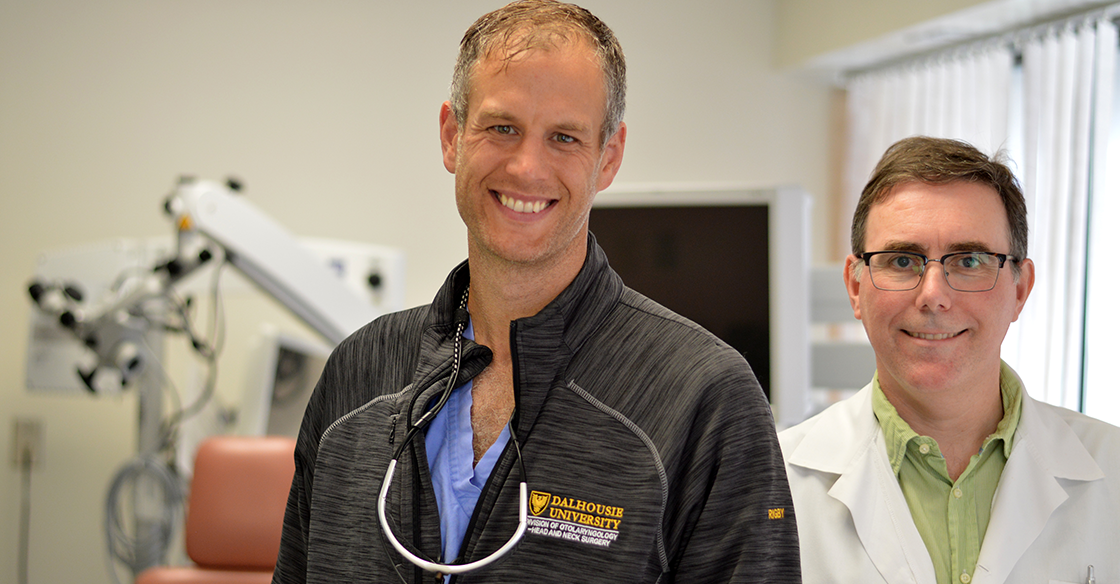
New sampling technique reduces likelihood of throat cancer recurrence
Removing cancer of the throat is tricky business, given the concentration of vital bodily functions in such a small space. Here, a centimetre of tissue can make a world of difference.
“A lot of the characteristics you consider vital to your socialization, or who you are as a person, happen in the neck,” says head and neck oncology surgeon Dr. Matthew Rigby. “Speech, breathing, swallowing, eating, your appearance — it’s expensive real estate.”
His efforts to remove a tumour may have consequences for a patient’s saliva production, tongue function, the likelihood of choking and more. So he doesn’t want to remove too much, but removing too little could be even more serious.
A “positive margin” is when, during the removal of a tumour, a few cancer cells are left behind in surrounding tissues. This causes a recurrence of cancer and increases a patient’s odds of fatality by one in five. Even those who survive recurrence must go through another round of cancer treatment, taking a toll on them as well as the healthcare system. Positive margins, therefore, must be avoided.
Traditionally, Dr. Rigby, with the aid of pathologists, would remove the tumour and then sample surrounding tissues to ensure all were healthy. If cancer cells persisted, they continued to remove more tissue. Unfortunately, there’s a great deal of tissue to sample, and it’s difficult to be sure a wide enough margin has been removed. After auditing their own results in previous years, it was discovered that positive margins occurred in 12.9 per cent of cases. This was a good number when compared to other institutions, says Dr. Rigby, but he knew they could do better.
During his fellowship at the Mayo Clinic in Scottsdale, Arizona, Dr. Rigby practised a different method of testing for positive margins. Instead of sampling surrounding tissues for lingering cancer cells, they instead sampled the tumour, making sure there was a cut of healthy tissue surrounding it on all sides. Wherever a cut didn’t enclose the tumour completely, or was too thin, they returned to surgery and removed more tissue.
In 2015, he secured funding from his own Department of Surgery, as well as a grant from the Nova Scotia Health Research Foundation the following year. More recently, a $59,700 QE11 Foundation Translating Research Into Care (TRIC) grant was awarded. Dr. Rigby’s goal was to make the testing methods practised at the Mayo Clinic workable for the QEII.
With the help of pathologist Dr. Martin Bullock and others, a testing method based on the tumour itself was established beginning in January 2017. Already, more than 100 patients have gone through, and while data is still being collected, results thus far have been very promising.
“We already have interim data which shows an almost 10-times reduction in risk of recurrence,” says Dr. Rigby. “That’s huge.”
With this new method, the odds of a positive margin at the QEII have dropped from the aforementioned 12.9 per cent to 1.6 per cent. A reduction with the potential not only to save hundreds of thousands of dollars in healthcare costs, but also lives.
In the considered opinion of Dr. Bullock, who played a crucial role recruiting his fellow pathologists for this new screening method, their success can be practically replicated at other healthcare institutions across the country, provided they possess the necessary expertise and conviction.
“I think it’s certainly within the scope of every academic pathology department,” says Dr. Bullock.
Dr. Rigby and his colleagues see 150-200 new throat cancer patients a year from Nova Scotia, Prince Edward Island and New Brunswick. Because this change to their methodology was staff-driven, and all necessary retraining was accomplished with grants, it’s likely here to stay. Once their trial period ends later this year, Dr. Rigby hopes other Canadian healthcare institutions will recognize their results and follow suit.
“In 10 years, I hope there isn’t anyone not doing it,” he says.